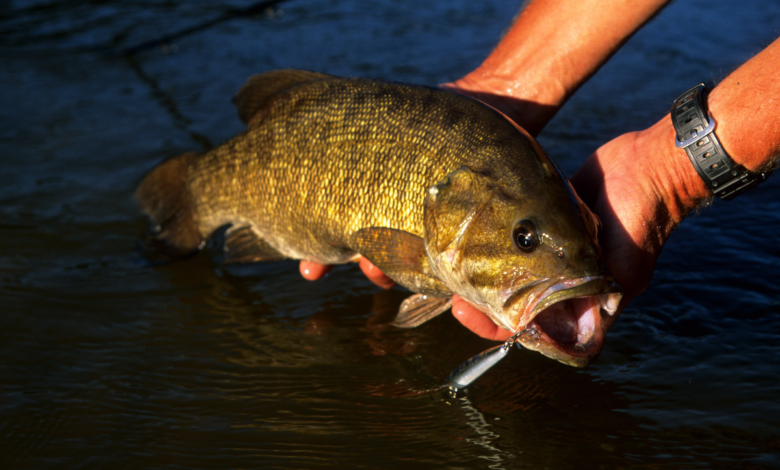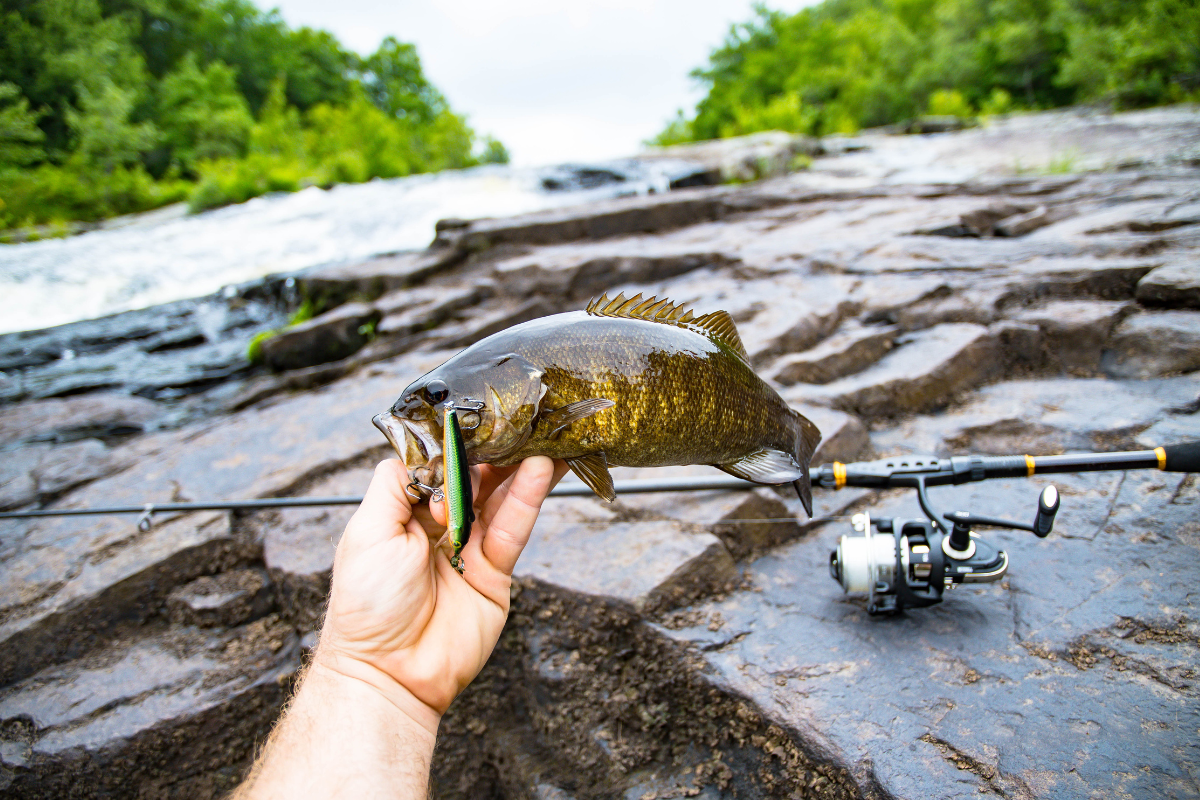How to Catch Smallmouth Bass: Here’s What You Need to Know

For many anglers, smallmouth bass is not the first preference. Because these fish prefer deeper waters and tend to move around a lot, not all anglers are sure about how to catch smallmouth. Many newbies even mistake the smallies for trout.
On the other hand, there are smallmouth fanatics who love the challenge of chasing the smallies. They have a carefully curated smallmouth arsenal to bag these awesome fighters.
While I am no diehard smallmouth fan, my years of fishing have taught me a lot about their behavior and the way they move around cover. So, here is a closer look at the ins and outs of smallmouth bass fishing.
Where to Find Smallmouth Bass
Smallmouth bass are found in every state in the U.S. except Louisiana and Florida. Unlike the largemouth, smallmouth bass are picky about their residential preferences. They prefer rocky habitats to find their favorite food… crawfish.
These fish like deeper waters or quick access to deeper waters from a shallow bed. For example, a rocky point stretching from a shallow to a deep section. Rocky bends, shallow spots with rocks and boulders, and humps close to deep water are hot spots for smallmouth. The larger ones often head for deep offshore structures which makes baiting difficult.
When bass spawn, they head to pea gravel coves or gravel flats in clear water. Keep in mind that smallmouth prefers good water quality and covers like weeds, docks, and large pieces of timber. I have found smallmouths in deep holes and deeper sections of weed beds.
Most freshwater systems of eastern and central North America have a healthy smallmouth bass population. Due to their preference for colder and cleaner water, they are found abundantly in the Great Lakes system and the St. Lawrence River. One of my favorite smallmouth bass fishing destinations is Lake Erie.
Further south, the Ouachita and the Neosho varieties of smallmouth bass are found in the water bodies of Oklahoma and Arkansas.
Spots like the Dale Hollow Lake in Tennessee, the Buffalo River, and the Elk and Holston Rivers are great locations for smallmouth fishing. For smallmouth bass fishing in Arizona, you can head to Lake Havasu on the Colorado River
The southern smallmouth prefers higher elevations near the mountains as these places are cooler. Keep in mind that rainfall patterns in southern reservoirs can turn the water muddy, making fishing for smallmouth bass tricky.
When to Fish for Smallmouth Bass
Even though smallmouth feeding patterns vary with the seasons, the species remains active between spring and fall. But if you are looking for a trophy smallmouth, you will need the right planning and a lot of tact.
Spring
Since smallmouth are more active in cold water than largemouth, fishing begins in early spring when the water temperatures are in the mid-50s. As spring progresses, bright sunny days with a water temperature between 48 to 55 degrees deliver excellent results.
In some locations, smallmouth prefer low-light hours for feeding. So, two hours around dawn and dusk are great times to throw in your bait.
Once the fish are in full-blown spawn mode in May, they move towards shallower flats. Smallmouth tend to defend their beds aggressively. So, dragging a bait right across its face can do the trick.
Post-spawn smallmouth is difficult to catch since the bass will spend a few weeks recuperating after spawning. The good news is that the lake water does not warm up uniformly. So, the post-spawn phase does not happen across an entire reservoir or lake at the same time.
Summer
When the water temperatures hit the 70s and 80s, the smallmouth move towards deeper waters. I have seen a smallmouth being caught from a depth of around 90 feet. In general, they prefer a depth of 25 to 35 feet to avoid the heat.
My suggestion is to head for the clearest and deepest lakes and reservoirs that remain cool in summer. The age-old summer formula of fishing early morning and late afternoon works great with smallmouth too. When fishing at night, go shallow. The combination of crayfish and bugs in the after-dark hours are the primary attraction for the bass.
Take advantage of midsummer cold fronts as these can make the deep-water bass move out of dormancy. They tend to move up and look for baitfish, striking greedily at almost every lure.
Fall
Fall is my favorite season for going after smallmouth as they tend to feed heavily before the temperatures drop in winter.
One easy way to locate the bass is to follow the schools of shiner and shad that are abundantly present, especially in the southeast. Shallow flats or creek mouths with deep to shallow transitions are spots where bass can feed recklessly.
I have noted that in reservoirs containing largemouth, targeting the smallmouth can get tough in the fall. In many cases, the smallies get beaten by the largemouth in striking the bait. So, I prefer to target smallmouth late in the season, when the temperatures are lower and the largemouth tends to get lethargic.
Winter
With the smallmouth retreating into their winter holes, fishing gets slow in winter. The metabolism of smallmouth bass drops and they move slowly. The key is to get your presentation closer to the bottom where they are lurking.
The best time for smallmouth bass fishing in winter is during the warmest hours of the day. I have found smallmouth bass on the edges of deep river holes on sunny winter afternoons. If the weather is too cold, wait till warmer spells when the daytime temperatures hit the low-40s.
Smallmouth Anatomy
Speaking of anatomy, the average weight of smallmouth bass is between 2 to 4 pounds and they typically have a brownish bronze color. This is the reason that they are called “brown bass”. However, the coloration can vary depending on the habitat and water clarity.
The smallmouth has a compressed body and dark patches radiating from the eyes. Unlike largemouth bass, their jaw does not extend beyond the eye – the most distinctive feature. Also, the dorsal fins of smallmouth are joined.
Best Rods and Reels for Smallmouth
The point is – everyone has their preferences about rods and reels for smallmouth. What I have realized over the years is that some rods are better suited for smallmouth.
In general, medium-light action spinning rod works well for smallmouth. But, remember that you target smallmouth in deeper water compared to largemouth. So, using a longer rod gives you the advantage of having more line out. Moreover, smallmouth stay further away from the shoreline in most cases. In clear waters, making a long cast with a longer rod is a good idea.
When it comes to reels, a basic spinning setup is good enough for smallmouth. I prefer using a mid-arbor reel with a smooth drag and a robust construction.
Since you do not focus on casting accuracy for smallmouth, a 2000-3000 size spinning reel should work well for beginners. However, you can pick a medium-size reel(4000-5500) to pair with longer rods. Coming to gear ratios, a spinning reel with a 6:1:1 ratio works well for deep water presentations with moving baits.
Lures and Bait
The baits that work on largemouth bass will work with smallmouth as well. The only thing is, you need to reduce the bait size. Also, make your bait seasonal to match the baitfish.
For starters, swimbaits are one of the best options in spring and fall. Vary the length of the bait depending on the type of baitfish around.
The drop shot rig is another great choice for bottom fishing in areas with deep aquatic vegetation or gravel bottoms. Without going into the jerkbait vs crankbait debate, I would say that both are excellent year-round baits for smallmouth bass.
When it comes to topwater action, smallmouths can be picky. Walking baits and Knocker Spooks are good options to lure post-spawn bronzebacks. Topwater frogs and Whooper Ploppers with a rotating tail tend to generate crazy strikes in fall.
If nothing is working, try using live bait like crayfish or minnows. Keep in mind, that crayfish is a major part of the diet for smallmouth, especially the larger ones. Other than that you can also use nightcrawlers or redworms.
What’s Important to Know
Here are a few more smallmouth bass fishing techniques that I have picked up over the years.
- Experiment with a variety of lure sizes and colors depending on the water clarity and light conditions. If one color does not work, another can be more effective.
- In fall, smallmouth tend to form tight groups. So chances of spotting an entire group are higher. Note that fishes of the same size school together.
- In summer, try to fish deeper. Some fish may be located deeper than 45 feet and take time to make a strike. But if you manage to hit the same spot persistently, you might bag a trophy bass.
- If you have an old and shredded worm in your bait box, do not hesitate to use it. Bass prefers ambushing wounded prey and can get drawn by a torn-up plastic worm in shallow waters.
- Smallmouth are highly sensitive to climatic changes and water pollution. You will not find them in unclean waters.

How to Catch Smallmouth Bass: FAQs
Are smallmouth bass easy to catch?
Smallmouth bass are not as easy to catch as the largemouth as they prefer deeper waters. However, if you pick the right time and bait, catching them is not too difficult.
What are smallmouth bass attracted to?
Surface noise attracts smallmouth bass. Adding scent to your baits is also a good idea.
What is the best time of day to catch smallmouth bass?
The hours around dawn and dusk are some of the best times to catch smallmouth bass, especially during summer. But under cloudy conditions, they can be caught throughout the day.
Final Thoughts
Hope this has given you an idea about how to catch smallmouth bass. Catching smallmouth bass like a pro is not difficult. However, they need a different approach than other varieties of bass and the key is locating their habitats and identifying feeding patterns.
Know that at specific periods in a year catching smallmouth gets challenging. Follow the calendar to keep track of the seasonal changes in their behavior and time it right.
While not as big as their cousin, the largemouth, the smallmouth have a great fighting spirit that makes them super fun to catch. Once you try smallmouth bass fishing, chances are, you will love it.


